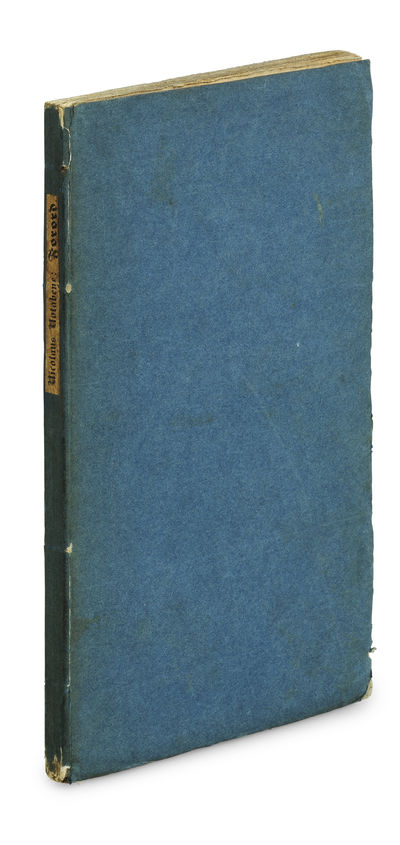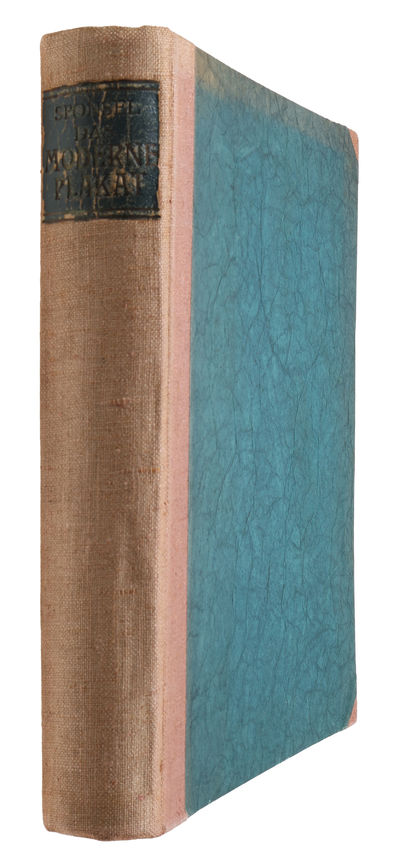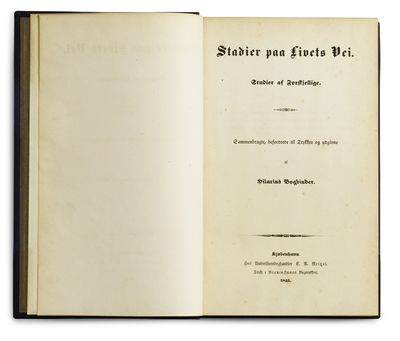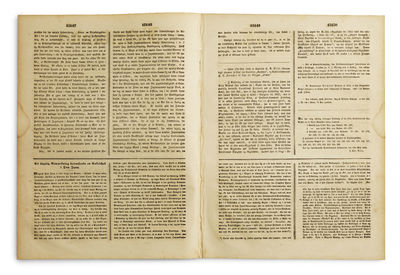THOMAS AQUINAS.
Summa theologiae - Incipit tertia pars summe sancti Thome de Aquino. Questio prima deconnenientia incarnationis. - [THE "FIVE WAYS" OF PROVING THAT GOD EXISTS]
Herman H. J. Lynge & Søn A/S
lyn60412
Venedig, Bernardino de Tridino - Stagnatius (Bernardino Benalio and Giovanni de Tridino / Bernardino Benalio and Giovanni de Tridino alias Tacuino), 10. April 1486. Folio (binding: 33x22 cm, block: 31,5x21,5 cm). In a charming contemporary full blindstamped pigskin binding over wooden boards. Five raised bands and early handwritten paper title-labels to spine. Spine and upper parts of boards with wear. Front hinge cracked, but still holding, although inner hinge very weak. Brass clasps, but no ties. Boards richly blindstamped with panels of acanthus-stamps and diamond-shaped stamps with two-headed dragons. Centre-panel with round stamps inside which a lion. Front board with "Iohannes" repeated four times inside banners. Pasted down front end-paper richly annotated in various hands - contemporary and early - and with several Ex libris - Ditlev Duckert, Sigurd&Gudrun Wandel, and "A-D". First blank with contemporary or near contemporary two-line inscription and a discreet stamp ("Veräusserte Dublette aus Stadtbibliothek Frankfurt am Main"). Neat, contemporary handwritten annotations to margins of many leaves. Pasted-down end-paper with many contemporary handwritten annotations as well. Beautifully printed in two columns throughout, 70 lines to each. Handpainted initials in red throughout and rubricated in red. A few leaves cropped at lower blank margin (far from affecting text), one leaf with a vertital tear (no loss), one leaf with a large brown stain, and one leaf with the red initials smudged. Otherwise just some occasional brownspotting. Generally very nice and well preserved. All in all a lovely copy. 200 ff. (a-p8, q-r6 (incl. the 3 ff. of Tabula) + aa-mm8 + 2 ff. Tabula) - thus fully complete, with both registers and the first blank.
The scarce and magnificent Tridino-edition of the seminal third part of the Summa Theologiae, Aquinas' unfinished magnum opus, of which each part constitutes a work in its own right, the third dealing with Christology. It is here that we find Aquinas' groundbreaking "Five Ways", his five arguments for the existence of God, arguably the most influential demonstration that God exists ever written. Each individual part of the "Summa" has its own separate printing history and its own bibliography, and the three parts are not expected to be found together. The "Pars Tertia" was printed for the first time in the 1470'ies, by Michael Wenssler. A reissue of this appeared in 1485. The present edition, by the renowned Venice book printer Tridino, constitutes the second edition of this landmark work of Western thought and the third appearance overall. Aquinas wrote his seminal magnum opus, the "Summa Theologiae", as an instructional guide for theology students and those interested in understanding Christian theology. Together, the three volumes that he wrote present the reasoning for almost all parts of Christian theology in the West, following a cycle beginning and ending with God, in between which we find Creation, Man, the Purpose of Man, Christ, and the Sacraments (unfinished), the third part dealing with Christ, the most fundamental question of the existence of God, and man's way of knowing him to exist. Although he left the "Summa" as such unfinished, the individual parts have come to form "one of the classics of the history of philosophy and one of the most influential works of Western literature." (Ross, James F.: "Summa theologiae, Christian Wisdom Explained Philosophically", 2003. P. 165). Determining that the way which leads to God is Christ, the path to God becomes the theme of Pars III of the "Summa", where we find Aquinas' Christology developed in full, his seminal demonstration of the existence of God, and his assertation of the necessity of the incarnation. Centering on the unity of the divine and human in the person of Christ, Pars III argues that all human potentialities are made perfect in Jesus. Aquinas here focuses on Christ's true humanity, including his birth, passion, resurrection, and the symbolism of the cross, and combines the Christian and the non-Christian in a synthesis that comes to be defining for all later Christian thought and theological philosophy. The most famous and influential part of Pars III of the "Summa", however, is probably Aquinas' considerations of - and arguments for - the existence of God. Exploring the rational belief in God, amongst other things, Aquinas here presents his "Five Ways" for the first time. "Aquinas considers whether we can prove that God exists in many places in his writings. But his best-known arguments for the existence of God come in Ia, 2, 3(the "Five Ways")... [i]t would be foolish to suggest that the reasoning of the Five Ways can be quickly summarized in a way that does them justice. But their substance can be indicated in fairly uncomplicated terms. In general, Aquinas' Five Ways employ a simple pattern of argument. Each begins by drawing attention to some general feature of things known to us on the basis of experience. It is then suggested that none of these features can be accounted for in ordinary mundane terms, and that we must move to a level of explanation which transcends any with which we are familiar..." (Marenbon, Medieval Philosophy, 2004. Pp. 244-45). "The Five Ways, Latin Quinquae Viae, in the philosophy of religion, the five arguments proposed by St. Thomas Aquinas (1224/25-1274) as demonstrations of the existence of God. Aquinas developed a theological system that synthesized Western Christian (and predominantly Roman Catholic) theology with the philosophy of the ancient Greek thinker Aristotle (384-322 BCE), particularly as it had been interpreted by Aristotle's later Islamic commentators. In his "Summa Theologica", which he intended as a primer for theology students, Aquinas devised five arguments for the existence of God, known as the Five Ways, that subsequently proved highly influential. While much of Aquinas's system is concerned with special revelation-the doctrine of the Incarnation of God's Word in Jesus Christ-the Five Ways are examples of natural theology. In other words, they are a concerted attempt to discern divine truth in the order of the natural world. Aquinas's first three arguments-from motion, from causation, and from contingency-are types of what is called the cosmological argument for divine existence. Each begins with a general truth about natural phenomena and proceeds to the existence of an ultimate creative source of the universe. In each case, Aquinas identifies this source with God. Aquinas's first demonstration of God's existence is the argument from motion. He drew from Aristotle's observation that each thing in the universe that moves is moved by something else. Aristotle reasoned that the series of movers must have begun with a first or prime mover that had not itself been moved or acted upon by any other agent. Aristotle sometimes called this prime mover "God." Aquinas understood it as the God of Christianity. The second of the Five Ways, the argument from causation, builds upon Aristotle's notion of an efficient cause, the entity or event responsible for a change in a particular thing. Aristotle gives as examples a person reaching a decision, a father begetting a child, and a sculptor carving a statue. Because every efficient cause must itself have an efficient cause and because there cannot be an infinite chain of efficient causes, there must be an immutable first cause of all the changes that occur in the world, and this first cause is God. Aquinas's third demonstration of God's existence is the argument from contingency, which he advances by distinguishing between possible and necessary beings. Possible beings are those that are capable of existing and not existing. Many natural beings, for example, are possible because they are subject to generation and corruption. If a being is capable of not existing, then there is a time at which it does not exist. If every being were possible, therefore, then there would be a time at which nothing existed. But then there would be nothing in existence now, because no being can come into existence except through a being that already exists. Therefore, there must be at least one necessary being-a being that is not capable of not existing. Furthermore, every necessary being is either necessary in itself or caused to be necessary by another necessary being. But just as there cannot be an infinite chain of efficient causes, so there cannot be an infinite chain of necessary beings whose necessity is caused by another necessary being. Rather, there must be a being that is necessary in itself, and this being is God. Aquinas's fourth argument is that from degrees of perfection. All things exhibit greater or lesser degrees of perfection. There must therefore exist a supreme perfection that all imperfect beings approach yet fall short of. In Aquinas's system, God is that paramount perfection. Aquinas's fifth and final way to demonstrate God's existence is an argument from final causes, or ends, in nature (see teleology). Again, he drew upon Aristotle, who held that each thing has its own natural purpose or end. Some things, however-such as natural bodies-lack intelligence and are thus incapable of directing themselves toward their ends. Therefore, they must be guided by some intelligent and knowledgeable being, which is God." (Encycl. Britt.). "Thomas Aquinas's "Summa theological" was originally written as a teaching document, a guide for beginning theology students. At more than 3,500 pages, it may seem an intimidating introduction to Christian theology; however, the influence of the "Summa" exceeds its volume. Aquinas's work influenced every subject in the liberal arts, especially astronomy, logic, and rhetoric. Aquinas's methodical disputations, rhetorical style, and logic are as much an education as his insights on the balance of faith and reason within Christian doctrine." (University of Dayton Library). "During the high Middle Ages theology itself underwent important changes. In the eleventh and twelfth centuries, the study of logic and dialectic began to expand at the expense of grammar and rhetoric… Another change that accompanied this development was the effort to transform Christian doctrine from scattered pronouncements of Scripture, the Councils, and the Church Fathers into a coherent and systematic body of statements. This process culminates in Peter Lombard's "Sentences"…, and in St. Thomas Aquinas' "Summa Theologiae"." (Kristeller, Renaissance Thought and its Sources, 1979. P. 117). Hain:1470; Proctor: 4826; Graesse: 7:139.
The scarce and magnificent Tridino-edition of the seminal third part of the Summa Theologiae, Aquinas' unfinished magnum opus, of which each part constitutes a work in its own right, the third dealing with Christology. It is here that we find Aquinas' groundbreaking "Five Ways", his five arguments for the existence of God, arguably the most influential demonstration that God exists ever written. Each individual part of the "Summa" has its own separate printing history and its own bibliography, and the three parts are not expected to be found together. The "Pars Tertia" was printed for the first time in the 1470'ies, by Michael Wenssler. A reissue of this appeared in 1485. The present edition, by the renowned Venice book printer Tridino, constitutes the second edition of this landmark work of Western thought and the third appearance overall. Aquinas wrote his seminal magnum opus, the "Summa Theologiae", as an instructional guide for theology students and those interested in understanding Christian theology. Together, the three volumes that he wrote present the reasoning for almost all parts of Christian theology in the West, following a cycle beginning and ending with God, in between which we find Creation, Man, the Purpose of Man, Christ, and the Sacraments (unfinished), the third part dealing with Christ, the most fundamental question of the existence of God, and man's way of knowing him to exist. Although he left the "Summa" as such unfinished, the individual parts have come to form "one of the classics of the history of philosophy and one of the most influential works of Western literature." (Ross, James F.: "Summa theologiae, Christian Wisdom Explained Philosophically", 2003. P. 165). Determining that the way which leads to God is Christ, the path to God becomes the theme of Pars III of the "Summa", where we find Aquinas' Christology developed in full, his seminal demonstration of the existence of God, and his assertation of the necessity of the incarnation. Centering on the unity of the divine and human in the person of Christ, Pars III argues that all human potentialities are made perfect in Jesus. Aquinas here focuses on Christ's true humanity, including his birth, passion, resurrection, and the symbolism of the cross, and combines the Christian and the non-Christian in a synthesis that comes to be defining for all later Christian thought and theological philosophy. The most famous and influential part of Pars III of the "Summa", however, is probably Aquinas' considerations of - and arguments for - the existence of God. Exploring the rational belief in God, amongst other things, Aquinas here presents his "Five Ways" for the first time. "Aquinas considers whether we can prove that God exists in many places in his writings. But his best-known arguments for the existence of God come in Ia, 2, 3(the "Five Ways")... [i]t would be foolish to suggest that the reasoning of the Five Ways can be quickly summarized in a way that does them justice. But their substance can be indicated in fairly uncomplicated terms. In general, Aquinas' Five Ways employ a simple pattern of argument. Each begins by drawing attention to some general feature of things known to us on the basis of experience. It is then suggested that none of these features can be accounted for in ordinary mundane terms, and that we must move to a level of explanation which transcends any with which we are familiar..." (Marenbon, Medieval Philosophy, 2004. Pp. 244-45). "The Five Ways, Latin Quinquae Viae, in the philosophy of religion, the five arguments proposed by St. Thomas Aquinas (1224/25-1274) as demonstrations of the existence of God. Aquinas developed a theological system that synthesized Western Christian (and predominantly Roman Catholic) theology with the philosophy of the ancient Greek thinker Aristotle (384-322 BCE), particularly as it had been interpreted by Aristotle's later Islamic commentators. In his "Summa Theologica", which he intended as a primer for theology students, Aquinas devised five arguments for the existence of God, known as the Five Ways, that subsequently proved highly influential. While much of Aquinas's system is concerned with special revelation-the doctrine of the Incarnation of God's Word in Jesus Christ-the Five Ways are examples of natural theology. In other words, they are a concerted attempt to discern divine truth in the order of the natural world. Aquinas's first three arguments-from motion, from causation, and from contingency-are types of what is called the cosmological argument for divine existence. Each begins with a general truth about natural phenomena and proceeds to the existence of an ultimate creative source of the universe. In each case, Aquinas identifies this source with God. Aquinas's first demonstration of God's existence is the argument from motion. He drew from Aristotle's observation that each thing in the universe that moves is moved by something else. Aristotle reasoned that the series of movers must have begun with a first or prime mover that had not itself been moved or acted upon by any other agent. Aristotle sometimes called this prime mover "God." Aquinas understood it as the God of Christianity. The second of the Five Ways, the argument from causation, builds upon Aristotle's notion of an efficient cause, the entity or event responsible for a change in a particular thing. Aristotle gives as examples a person reaching a decision, a father begetting a child, and a sculptor carving a statue. Because every efficient cause must itself have an efficient cause and because there cannot be an infinite chain of efficient causes, there must be an immutable first cause of all the changes that occur in the world, and this first cause is God. Aquinas's third demonstration of God's existence is the argument from contingency, which he advances by distinguishing between possible and necessary beings. Possible beings are those that are capable of existing and not existing. Many natural beings, for example, are possible because they are subject to generation and corruption. If a being is capable of not existing, then there is a time at which it does not exist. If every being were possible, therefore, then there would be a time at which nothing existed. But then there would be nothing in existence now, because no being can come into existence except through a being that already exists. Therefore, there must be at least one necessary being-a being that is not capable of not existing. Furthermore, every necessary being is either necessary in itself or caused to be necessary by another necessary being. But just as there cannot be an infinite chain of efficient causes, so there cannot be an infinite chain of necessary beings whose necessity is caused by another necessary being. Rather, there must be a being that is necessary in itself, and this being is God. Aquinas's fourth argument is that from degrees of perfection. All things exhibit greater or lesser degrees of perfection. There must therefore exist a supreme perfection that all imperfect beings approach yet fall short of. In Aquinas's system, God is that paramount perfection. Aquinas's fifth and final way to demonstrate God's existence is an argument from final causes, or ends, in nature (see teleology). Again, he drew upon Aristotle, who held that each thing has its own natural purpose or end. Some things, however-such as natural bodies-lack intelligence and are thus incapable of directing themselves toward their ends. Therefore, they must be guided by some intelligent and knowledgeable being, which is God." (Encycl. Britt.). "Thomas Aquinas's "Summa theological" was originally written as a teaching document, a guide for beginning theology students. At more than 3,500 pages, it may seem an intimidating introduction to Christian theology; however, the influence of the "Summa" exceeds its volume. Aquinas's work influenced every subject in the liberal arts, especially astronomy, logic, and rhetoric. Aquinas's methodical disputations, rhetorical style, and logic are as much an education as his insights on the balance of faith and reason within Christian doctrine." (University of Dayton Library). "During the high Middle Ages theology itself underwent important changes. In the eleventh and twelfth centuries, the study of logic and dialectic began to expand at the expense of grammar and rhetoric… Another change that accompanied this development was the effort to transform Christian doctrine from scattered pronouncements of Scripture, the Councils, and the Church Fathers into a coherent and systematic body of statements. This process culminates in Peter Lombard's "Sentences"…, and in St. Thomas Aquinas' "Summa Theologiae"." (Kristeller, Renaissance Thought and its Sources, 1979. P. 117). Hain:1470; Proctor: 4826; Graesse: 7:139.
Adress:
Silkegade 11
DK-1113 Copenhagen Denmark
Telefon:
CVR/VAT:
DK 16 89 50 16
E-post:
Webb:
![Summa theologiae - Incipit tertia pars summe sancti Thome de Aquino. Questio prima deconnenientia incarnationis. - [THE "FIVE WAYS" OF PROVING THAT GOD EXISTS] (photo 1)](https://d3525k1ryd2155.cloudfront.net/h/972/316/1547316972.0.l.jpg)
![Summa theologiae - Incipit tertia pars summe sancti Thome de Aquino. Questio prima deconnenientia incarnationis. - [THE "FIVE WAYS" OF PROVING THAT GOD EXISTS] (photo 2)](https://d3525k1ryd2155.cloudfront.net/h/972/316/1547316972.1.l.0.jpg)
![Summa theologiae - Incipit tertia pars summe sancti Thome de Aquino. Questio prima deconnenientia incarnationis. - [THE "FIVE WAYS" OF PROVING THAT GOD EXISTS] (photo 3)](https://d3525k1ryd2155.cloudfront.net/h/972/316/1547316972.2.l.0.jpg)
![Summa theologiae - Incipit tertia pars summe sancti Thome de Aquino. Questio prima deconnenientia incarnationis. - [THE "FIVE WAYS" OF PROVING THAT GOD EXISTS] (photo 4)](https://d3525k1ryd2155.cloudfront.net/h/972/316/1547316972.3.l.0.jpg)
![Summa theologiae - Incipit tertia pars summe sancti Thome de Aquino. Questio prima deconnenientia incarnationis. - [THE "FIVE WAYS" OF PROVING THAT GOD EXISTS] (photo 5)](https://d3525k1ryd2155.cloudfront.net/h/972/316/1547316972.4.l.0.jpg)
![Summa theologiae - Incipit tertia pars summe sancti Thome de Aquino. Questio prima deconnenientia incarnationis. - [THE "FIVE WAYS" OF PROVING THAT GOD EXISTS] (photo 6)](https://d3525k1ryd2155.cloudfront.net/h/972/316/1547316972.5.l.0.jpg)
![Summa theologiae - Incipit tertia pars summe sancti Thome de Aquino. Questio prima deconnenientia incarnationis. - [THE "FIVE WAYS" OF PROVING THAT GOD EXISTS] (photo 7)](https://d3525k1ryd2155.cloudfront.net/h/972/316/1547316972.6.l.0.jpg)
![Summa theologiae - Incipit tertia pars summe sancti Thome de Aquino. Questio prima deconnenientia incarnationis. - [THE "FIVE WAYS" OF PROVING THAT GOD EXISTS] (photo 8)](https://d3525k1ryd2155.cloudfront.net/h/972/316/1547316972.7.l.0.jpg)
![Summa theologiae - Incipit tertia pars summe sancti Thome de Aquino. Questio prima deconnenientia incarnationis. - [THE "FIVE WAYS" OF PROVING THAT GOD EXISTS] (photo 9)](https://d3525k1ryd2155.cloudfront.net/h/972/316/1547316972.8.l.0.jpg)
![Summa theologiae - Incipit tertia pars summe sancti Thome de Aquino. Questio prima deconnenientia incarnationis. - [THE "FIVE WAYS" OF PROVING THAT GOD EXISTS] (photo 10)](https://d3525k1ryd2155.cloudfront.net/h/972/316/1547316972.9.l.0.jpg)
![Summa theologiae - Incipit tertia pars summe sancti Thome de Aquino. Questio prima deconnenientia incarnationis. - [THE "FIVE WAYS" OF PROVING THAT GOD EXISTS] (photo 11)](https://d3525k1ryd2155.cloudfront.net/h/972/316/1547316972.10.l.0.jpg)
![Summa theologiae - Incipit tertia pars summe sancti Thome de Aquino. Questio prima deconnenientia incarnationis. - [THE "FIVE WAYS" OF PROVING THAT GOD EXISTS] (photo 12)](https://d3525k1ryd2155.cloudfront.net/h/972/316/1547316972.11.l.0.jpg)
![Summa theologiae - Incipit tertia pars summe sancti Thome de Aquino. Questio prima deconnenientia incarnationis. - [THE "FIVE WAYS" OF PROVING THAT GOD EXISTS] (photo 13)](https://d3525k1ryd2155.cloudfront.net/h/972/316/1547316972.12.l.0.jpg)





